About Canine Hydrotherapy
About CANINE HYDROTHERAPY
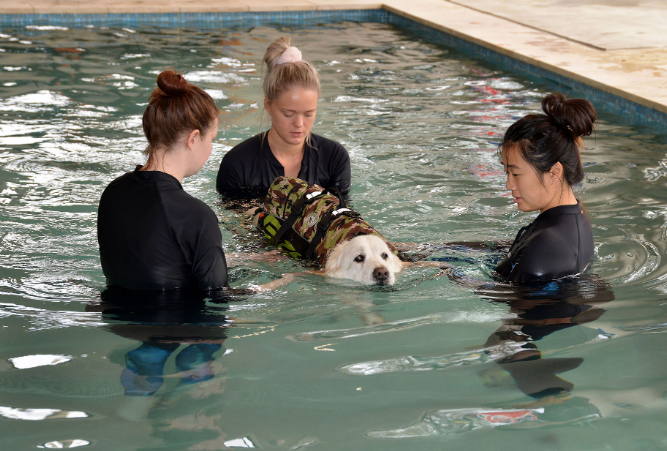
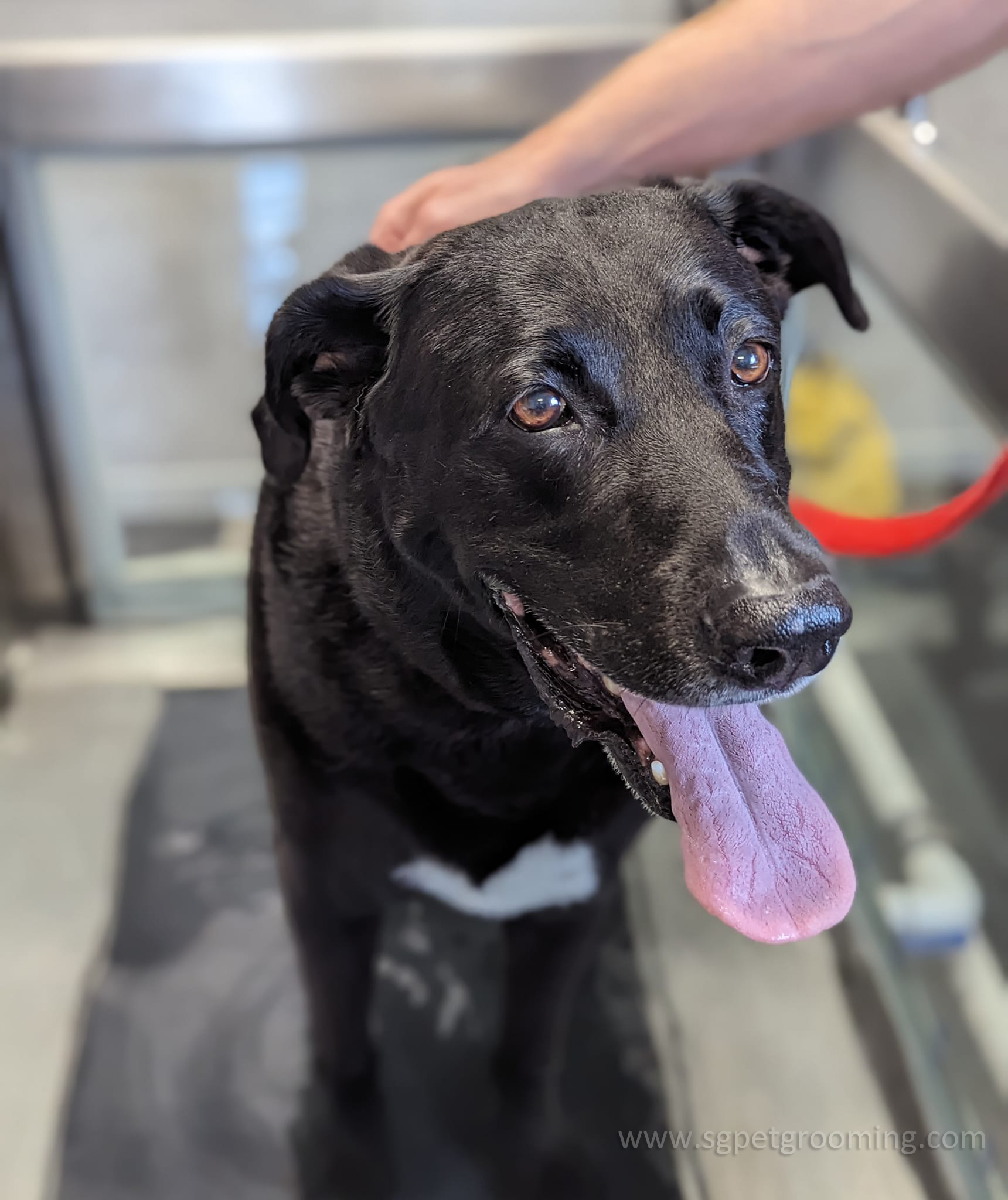
What is Hydrotherapy?
“The name Hydrotherapy comes from the Greek words “Hydros” meaning water and “therapia” meaning treatment”.
Hydrotherapy is a form of low impact, non-weight bearing exercise that aids in the rehabilitation of sore, weak and painful joints.
Initially non-weight bearing conditions are treated with controlled swimming, as the flotation supports the entire body weight and the limbs move freely without the “jarring” effect of exercising on hard ground. Swimming is an excellent form of exercise because most of the muscles normally used in movement are involved - without the stresses caused by running on hard ground.
On land, each footfall creates a shock wave, which travels up the limb and is absorbed by bones, tendons and joints. While these stresses are necessary to maintain healthy, strong bone if severe, or repetitive, these shock waves can actually damage or weaken the limb, particularly an arthritic joint or one recovering from an injury or surgery.
Controlled swimming allows the "working out" and strengthening of the muscles while avoiding this potentially damaging concussion. Also, because of the increased resistance to movement, the muscles have to work harder than they would do on land.
The terms “hydrotherapy” and “swimming” when used properly can mean two different things. Swimming for a dog means being completely buoyant in the water, this is not the same as hydrotherapy.
Hydrotherapy is a more controlled type of aquatic exercise and is often used for dogs to build muscles in weak areas without allowing the dog to “overdo it.”
Hydrotherapy is very useful for dogs that are lame or sore.
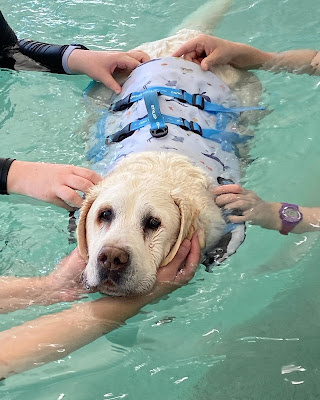 |
| Senior dog Tara during her hydro session |
It can be used for chronic conditions such as arthritis, lameness, post – operative recovery, hip, joint and soft tissue problems, cruciate ligament damage, spinal injuries, muscle weakness, sciatica and rehabilitation after injury and sickness.
It aids in weight loss and general fitness. It can assist in reducing pain and inflammation. Animals with arthritis have very swollen and painful joints. Walking and exercise becomes very uncomfortable for them and they may also find it difficult to get back up after lying down for long periods of time.
Most animals gain weight, as they are much less active, putting even more pressure on their joints this is where hydrotherapy helps with this problem.
Swimming your dog in an indoor heated dog pool facility is an excellent way for dogs to recover from surgery, to strengthen and condition, to improve general fitness, muscle tone and stamina, to lose weight and to learn how to swim.
Swimming dogs in dams, rivers or oceans can have disadvantages if they have a condition. While the dog can swim freely the water is cold and the following points need to be considered:
• Cold temperatures constrict blood vessels close to the skin restricting blood flow and oxygen to the muscles and essential organs and causes the blood to move away from the peripheral limbs risking pain and muscle strain. This can be very painful and makes the muscles less efficient.
• Even in summer months the water can be very cold.
• Cold water can lead to increased stiffness in arthritic dogs.
• Lack of control with swimming can allow for an accident to happen or drowning.
• It can put the dog in risk of gastroenteritis, skin, eye and ear problems.
Swimming in warm water allows the muscles to work more efficiently and helps to aid blood circulation without risk of cramping. It also helps reduce some of the swelling in joints. The increased limited weight bearing exercise makes joint movement easier; helps regain fitness and can help them to lose weight they may have gained. Water temperature should be between 26-30 degrees C.
Muscle wastage begins within 3 days of any immobilisation so to prevent further weakness or injury it is important to rebuild, through safe exercise, any muscles that have deteriorated.
Dogs can start to swim from as early as 4-6 months of age. For puppies and dogs learning how to swim it is important that their first experience with water is not going to be a stressful one, the aim is to make them confident and to give them an enjoyable time.
It is a great conditioning tool for working, show or sporting dogs. It builds their muscles, conditions them, and expends their energy while they are having fun. For dogs that are not getting enough exercise, this burns more energy than any other form of a work out.
Senior dogs benefit from the increased mobility and they are able to delay the effects of debilitating arthritis and other joint diseases. A regular regime of swimming also works their cardiovascular systems and provides weight control.
For weight management, swimming your dog is an ideal form of exercise. The excess weight on the dog is really taxing on their joints, heart and lungs. By going in a pool, the strain is relieved from the joints while they are getting a really good cross section workout. That is something that cannot be achieved on land. Their weight will continue to place additional wear on their bodies.
For really obese dogs walking distances is nearly impossible and the pool is one of the best things for them to get back in shape.
Having a spinal injury can cause impairment of motor function, and hydrotherapy can provide support and allows the dog to exercise its muscles while nerve regeneration is taking place.
“Did you know that a five-minute swim is equivalent to a 5k walk!”?
The Benefits of Canine Hydrotherapy
✔️ Speedy recovery after surgery
✔️ Overweight dogs can gain fitness and lose weight
✔️ Arthritic and senior dogs
✔️ Condition Training
✔️ Swim Lessons and Fun!
✔️ Allows exercise for pets with disabilities
✔️ Great bonding activity with your canine
✔️ Pre and Post operative conditioning after orthopaedic surgery
✔️ Improves quality of life
✔️ Reduces inflammation of injured joints, fractures and soft tissue injuries
✔️ Increased circulation, endurance, flexibility, range of motion, and balance
✔️ Decreased swelling in joints
✔️ Increased co-ordination
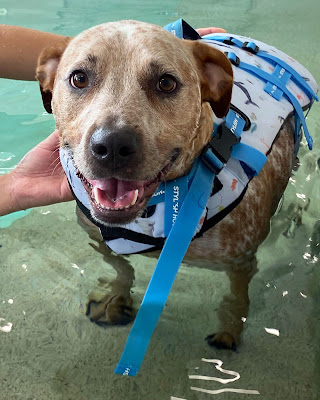 |
| Cattle Dog Bella started hydrotherapy to assist with a hip issue and sciatica |
✔️ Muscle development
✔️ Cardio-vascular improvement and conditioning
✔️ Increased confidence
✔️ Increased energy level in aging dogs
✔️ Excellent for mental stimulation and general convalescence
✔️ Makes joints more supple
✔️ Improves stamina and strengthens muscles
✔️ Can aid in pain relief of DJD (Degenerative Joint Disease)
✔️ Builds general fitness helping with injury prevention
✔️ Exercises all muscles allowing to rebuild or maintain cardio vascular fitness.
Dogs that need improvement with proprioception, core strength, flexion, extension, muscle building, gait improvement and cardiovascular strengthening will certainly benefit from hydrotherapy.
The following conditions have also been helped by Hydrotherapy:
• Knee surgeries
• Anterior cruciate ligament surgery
• Full hip replacement
• Femoral Head and Neck Excision
• Intervertebral Disk Disease
• Amputation of a limb
• Hip and Elbow dysplasia in young and old dogs
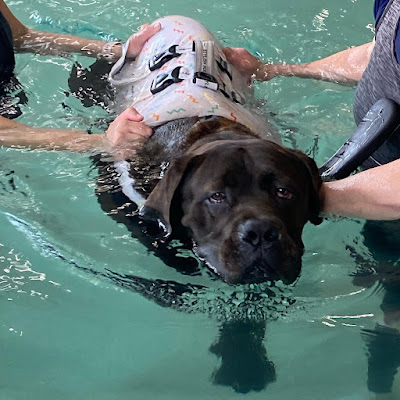 |
| 10-month old Mastiff x puppy Bruce had a luxating patella and started hydro to strengthen his legs |
• Luxating Patella
• Fractures
• Degenerative joint disease
• Weakened spine
• Osteoarthritis
• Spondylosis
• Degenerative Myelopathy
• Neurological disorders
• Early signs of cognitive dysfunction
• Osteochondritis Dissecans (OCD)
• Soft Tissue Injuries
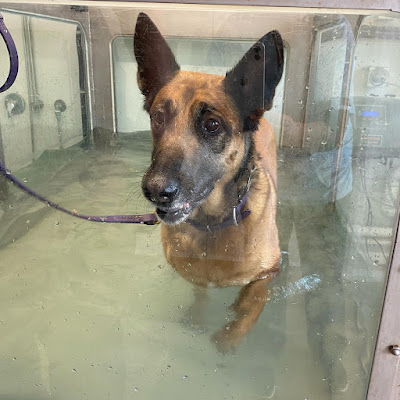 |
| Malinois Wisdom using the underwater treadmill as part of her injury recovery |
Post surgery hydrotherapy normally starts around 4-6 weeks after their operation.
Your veterinarian will guide you as to when would be the most appropriate time to start hydrotherapy for your dog.
A Vet referral form should be filled out by your Vet and given to your Hydro therapist before treatment commences. This will assist the Hydro therapist in your dog’s rehabilitation process.
Swimming can reduce the dog’s recovery time by half.
“Swimming is a wonderful activity for dogs young and old.”
Water can be very calming for dogs and can reduce levels of stress in addition to assisting with improving many bodily functions.
Dogs can swim just for fun too!! They do not have to have a medical condition to swim.
It is a wonderful mental stimulus, burns off energy, it is a great cross training especially for those people that cant exercise their dogs daily due to work and busy lifestyles. Dogs can have a lot of fun chasing a ball in the water or retrieving a Frisbee.
【 Go Back 】 | 【 Close this window 】



